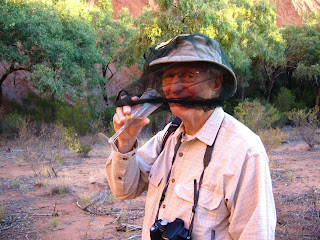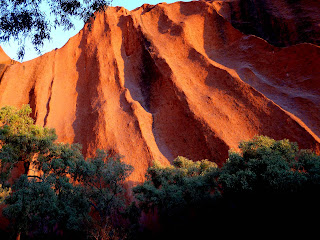 A pied butcherbird under our tent
A pied butcherbird under our tent Crested pigeon
Crested pigeon Zebra finches -- so cute!
Zebra finches -- so cute! More zebra finches
More zebra finches And yet more zebra finches
And yet more zebra finches This is the famous Mutitjulu waterhole at Uluru
This is the famous Mutitjulu waterhole at Uluru Joyce with her fly net at Uluru
Joyce with her fly net at Uluru JPK with his fly net at Uluru
JPK with his fly net at Uluru JPK demonstrating the fine art of drinking with a fly net in place
JPK demonstrating the fine art of drinking with a fly net in place A red roo and a gray-blue roo at Kata Tjuta
A red roo and a gray-blue roo at Kata Tjuta This photo of Uluru and the next 9 photos were taken at sunset
This photo of Uluru and the next 9 photos were taken at sunset





 This photo and the next show that the originally horizontal layers of Uluru were rotated at about a 90 degree angle when they were pushed up about 300 million years ago
This photo and the next show that the originally horizontal layers of Uluru were rotated at about a 90 degree angle when they were pushed up about 300 million years ago

 Uluru from our tent
Uluru from our tent Our tent at Longitude 131
Our tent at Longitude 131 Dwayne the didgeridoo player and Longitude 131 behind him
Dwayne the didgeridoo player and Longitude 131 behind him Another view of Uluru from our tent a few minutes later
Another view of Uluru from our tent a few minutes later The climbing chain on Uluru
The climbing chain on UluruWe returned from Papua New Guinea (PNG) to Cairns today, April 9, two days early, because of security concerns which will be the subject of the next blog. Suffice it to say for now that PNG engaged me in ways that I never expected. Notwithstanding my having re-read Margaret Mead's Growing Up in New Guinea just before and during our visit to PNG, it was an unnerving surprise to witness a stone age culture still thriving in the 21st century, and the inevitable stresses arising from the intrusion of the West and the demands that it places on New Guineans. Details to follow.
In the meantime, here is our post from our visit to the Outback and Uluru-Kata Tjuta National Park.
We arrived at Ayers Rock airport on Monday, March 31, after an uneventful flight from Melbourne and were met by one of the Longitude 131 staff who drove us to the resort in a gussied-up orange Toyota Land Cruiser. The Longitude 131 resort consists of a number of bungalows which are raised steel structures covered by a tent-like fabric (and referred to by the staff as "tents.") See photos. (In Sydney we became positively entranced by the aborigine didgeridoo, and Longitude had Dwayne perform for the guests one evening during canapes before a candlelight dinner under the stars. More about this dinner later.)
In the meantime, here is our post from our visit to the Outback and Uluru-Kata Tjuta National Park.
We arrived at Ayers Rock airport on Monday, March 31, after an uneventful flight from Melbourne and were met by one of the Longitude 131 staff who drove us to the resort in a gussied-up orange Toyota Land Cruiser. The Longitude 131 resort consists of a number of bungalows which are raised steel structures covered by a tent-like fabric (and referred to by the staff as "tents.") See photos. (In Sydney we became positively entranced by the aborigine didgeridoo, and Longitude had Dwayne perform for the guests one evening during canapes before a candlelight dinner under the stars. More about this dinner later.)
The main dining room/lobby/reading room is also a raised steel structure with its own tent-like roof. Uluru (oo-loo-roo) dominates the landscape, rising out of the essentially flat desert plain around it. It is plainly visible from every point in Longitude 131.
On our first afternoon we were taken to view Uluru as the sun set, while the guide related the aborigine tales about the Mala people and the spirits that they invested in its myriad shapes, caves, openings and rock formations. According to legend, the Mala people were driven out of the Uluru area and succeeded by the Anangu people, to whom the land around Uluru was restored in 1985 as a national park, Uluru-Kata Tjuta National Park (1325 square km). It is leased to the Australian National Park Service for 99 years, and is managed by a council of eight Anangu and four whites.
Climbing Uluru was a favorite pastime for tourists until Uluru was restored to the Anangu, for whom Uluru is a sacred site not to be profaned by hikers. Unfortunately, there is no prohibition against climbing, just a firm reminder that it should not be done out of respect for the Anangu tradition. According to the guides, the tourism business could be adversely affected if there were an absolute ban, especially for tourists from Japan who apparently look forward to the climb. As it is, there are a number of restrictions on climbing such as wind velocity and temperature, both of which have led to deaths, and which effectively limit climbing to about two days per week. The hiking trail and its chain are clearly visible (see photo) but we did not see any climbers during either of our sunset and sunrise visits.
Uluru at sunset and sunrise is beyond description, as the light continuously paints it with so many colors and shadows. Our photos can only give a rough impression of the colors. Uluru is a reddish sandstone (arkose sandstone) whose color is a reflection of its iron content, and in some of the caves there are aboriginal drawings with some of the symbols that we see in aboriginal art at the Cultural Centre.
On our first afternoon we were taken to view Uluru as the sun set, while the guide related the aborigine tales about the Mala people and the spirits that they invested in its myriad shapes, caves, openings and rock formations. According to legend, the Mala people were driven out of the Uluru area and succeeded by the Anangu people, to whom the land around Uluru was restored in 1985 as a national park, Uluru-Kata Tjuta National Park (1325 square km). It is leased to the Australian National Park Service for 99 years, and is managed by a council of eight Anangu and four whites.
Climbing Uluru was a favorite pastime for tourists until Uluru was restored to the Anangu, for whom Uluru is a sacred site not to be profaned by hikers. Unfortunately, there is no prohibition against climbing, just a firm reminder that it should not be done out of respect for the Anangu tradition. According to the guides, the tourism business could be adversely affected if there were an absolute ban, especially for tourists from Japan who apparently look forward to the climb. As it is, there are a number of restrictions on climbing such as wind velocity and temperature, both of which have led to deaths, and which effectively limit climbing to about two days per week. The hiking trail and its chain are clearly visible (see photo) but we did not see any climbers during either of our sunset and sunrise visits.
Uluru at sunset and sunrise is beyond description, as the light continuously paints it with so many colors and shadows. Our photos can only give a rough impression of the colors. Uluru is a reddish sandstone (arkose sandstone) whose color is a reflection of its iron content, and in some of the caves there are aboriginal drawings with some of the symbols that we see in aboriginal art at the Cultural Centre.
One of our enduring memories of the sunset visit to Uluru is the presence of swarms of annoying flies. The only way to enjoy the visit is to put a fly net over one's head, which of course means that during the sundowner at Uluru one must lift the fly net in order to enjoy the beverage.
When you visit Uluru (as you surely will), don’t spend much time in the art gallery at the Cultural Centre; instead, watch the large screen video showing Anangu people doing ritual dances and body painting (unexplained because there is no audio, at the request of the aborigines). The finest aboriginal art is on exhibition at galleries in the major cities such as the Art Gallery of New South Wales in Sydney, and having viewed the aboriginal gallery while in Sydney, we were quite disappointed in the art at the Cultural Centre.
On the morning of our third day here we visited Kata Tjuta, also known as the Olgas or “many heads,” including the Walpa (“windy”) Gorge. During this visit we saw our first wild kangaroos, a red roo and a blue roo, with the blue roo carrying a baby roo in her pouch. We also saw some pied butcherbirds, a willy wagtail, and a flock of tiny zebra finches.
On the morning of our third day here we visited Kata Tjuta, also known as the Olgas or “many heads,” including the Walpa (“windy”) Gorge. During this visit we saw our first wild kangaroos, a red roo and a blue roo, with the blue roo carrying a baby roo in her pouch. We also saw some pied butcherbirds, a willy wagtail, and a flock of tiny zebra finches.
2 comments:
lovely photos. So many nooks and crannies around the geologic formations, I'm sure the exploring was great. The water hole and tree filled canyon must be unusual in this desert, so I'm sure they attract any wildlife around there. Still sparse I would guess though.
The red kangaroo apparently comes in two color morphs, red and grey-blue so perhaps those two individuals were the same species. Apparently it is the females that are more often blue. I'm glad you let us know it was a female carrying a juvenile because I initially thought it was a "super" male.
Sorry you had to live in a tent. Looks like it was rough going. Those Aussies have a reputation as a resilient bunch, but they need to take it easy on visitors.
These pictures are SO nice, i can't believe that something could actually have been thrust up from the land only in one place! that is so cool
the culture center's video sounds like it would have been a lot of fun to watch, but i am sorry that the art was below expectations.
I think that those tent look like a lot of fun, they have a great view, and its almost like going to sleep right outside, in the Outback!
Its so cool that you got to see a little joey! they are just plain adorable!
I'm glad you guys are having fun!
<3
xoxoxoxo
Post a Comment